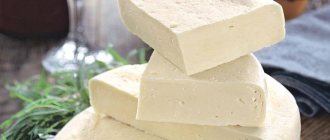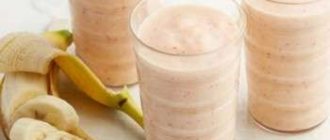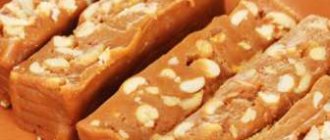Russian cheese is a semi-hard rennet cheese made from pasteurized cow's milk.
The Russian Cheese brand does not have a copyright holder and is produced by a large number of Russian, Belarusian, Ukrainian and Latvian factories.
Russian cheese is considered one of the most popular types of this dairy product.
Firstly, this cheese is one of the constant varieties: for as long as we can remember, it has been present on the shelves of our stores.
Secondly, there is always a huge assortment of this type of cheese, which depends on the manufacturer, and we have a lot of them.
History of Russian cheese
The variety was developed in the Soviet Union in 1960 by the Institute of Cheese Industry.
The production of Russian cheese first began at a factory in the city of Uglich. From this enterprise the product went directly to the shelves of domestic grocery stores. Affordable price and high quality quickly made it a product of mass demand. Due to high demand, Russian cheese was produced in volumes of up to 85 thousand tons annually. None of the other varieties could compare with it in this regard. Gradually, the Uglich plant transferred the technology for making such a popular cheese to other cheese-making enterprises, since it could no longer cope with the ever-increasing production volumes. Decades have passed, but Russian cheese is still no less loved by domestic consumers.
Description
Russian cheese has an elastic consistency, a beautiful creamy, slightly yellow color and small holes of different shapes. The taste is pronounced, sour, traditional for semi-hard and hard varieties. After 70 days of aging from the moment of production, the dairy product goes on sale. Its cost is not too high, which makes the cheese even more popular.
This variety first appeared on the shelves in the early 60s. During the manufacturing process we used milk from the Uglichesky State Farm. The variety has found wide application in cooking: it is used for making sandwiches, salads and snacks, grated and added to hot dishes.
Russian cheese is used to bake meat, fish and vegetables, and prepare pizza, pastries and casseroles.
The benefits and harms of Russian cheese
Russian is a variety made from pasteurized cow's milk and is classified as a semi-hard cheese. Since only high-quality food raw materials are used for its production, it is enriched with many vitamins and vital microelements.
If we compare the benefits and harms of Russian cheese, it can be noted that it has a positive effect on a healthy body not burdened with chronic diseases. It contains:
- vitamin A;
- vitamin B2;
- vitamin B6;
- vitamin B12;
- vitamin PP;
- calcium;
- magnesium;
- zinc;
- phosphorus.
The product strengthens the skeletal system. The beneficial properties of cheese have a beneficial effect on the nervous system, the condition of teeth and hair. In addition, it is a natural source of protein and supports healthy muscles.
However, when talking about the benefits of Russian cheese, we must not forget about the possible harm. The fact is that this product contains beef fat, which is considered quite “heavy” for the body. Excessive consumption of cheese can cause severe stomach discomfort and digestive problems.
Production technology
Russian cheese is produced according to GOST. This is one of those cheeses that is characterized by a high degree of lactic fermentation and a low second heating temperature.
Another peculiarity of the industrial production of this cheese is that mesophilic lactic acid streptococcal starters are used to ferment milk, and during the ripening process the heads change temperature conditions three times (10-12°, 14-16° and again 10-12°C).

The production process includes several successive stages:
- Cleaning and cooling of milk to +6…+8°С (to prevent microbial contamination).
- Maturation of milk (to increase its acidity). To do this, cooled milk is kept for 10-14 hours at a temperature of +10...+12°C.
- Normalization and pasteurization. Milk is normalized by fat, bringing it to the required mass fraction according to the technological instructions. Normalized milk is pasteurized in order to suppress the growth of microbes in it, inhibit existing enzymes and prepare it for coagulation. After pasteurization, the raw material is cooled to the coagulation temperature (32-34°C).
- Curdling of milk. Ferment and calcium chloride solution are added to the prepared milk. Within 25-30 minutes, a clot forms.
- Crushing the clot. After formation, the curd is cut, crushed and kneaded to obtain fine cheese grains. At this stage, about 30% of the whey is removed.
- Second heating. When producing Russian cheese, it lasts 15-30 minutes at a temperature of 38-41°C. The cheese grain is partially salted.
- Dehydration. After heating, the grain is kneaded again for 30-50 minutes. At the same time, its acidity is controlled.
- Head molding. The dried grain is fed into a molding machine to form a layer, which is cut into pieces of the required size. These pieces are placed in molds, in which they are self-pressed for 25-30 minutes. After this, the heads are numbered with plastic numbers.
- Pressing. The formed heads are fed under the press for 1.5-4 hours.
- Salting. Salting of Russian cheese is carried out by immersing the heads in a circulating brine at a temperature of +8...+12°C for 3-5 days.
- Maturation. After salting, the heads are dried (2-3 days) and sent to maturation chambers for 1.5-2.5 months. After they are ripe, the heads are washed, labeled, packaged in plastic film or coated with paraffin.
This long technological process for making Russian cheese gives it a delicate texture and a pleasant sour aftertaste, which sets it apart from other semi-hard varieties. On the cut it has a beautiful fine-bubble pattern.
What to cook from Russian cheese
This type of cheese can be called universal, since it is suitable for almost any occasion: daily breakfasts, holiday feasts, picnics, snacks, etc. Almost any combination of products with Russian cheese is possible. Most often they cook with it:
- cold and hot sandwiches, canapés;
- julienne and casseroles;
- pizza and pasta;
- baked dishes from vegetables, meat and poultry;
- salads.
This cheese can be combined with any bread, fried and eaten as an independent snack. In our virtual cookbook you will find a variety of recipes with Russian cheese that are easy and quick to prepare. Treat yourself and your loved ones to simple and delicious dishes!
How is product quality determined?
To ensure the quality of the cheese, carefully read the label from which ingredients the product is made. The composition of the natural product does not include vegetable proteins and fats. If there are any, this indicates low quality. The plastic vacuum packaging in which the cheese is sold should not be damaged or greasy. The dried crust should raise doubts. Uniform coloring, fresh crust, absence of serum in the eyes, and mold on the surface indicate freshness.
There is another way to determine quality. Take a small piece of cheese and bend it. A quality product should not break. You can make a purchase with confidence.
What wine goes with Altai cheese
In the classical sense, Russian cheese does not belong to those varieties that are often consumed for aesthetic taste reasons. But still, if you only have it on hand, and you really want to feel like you’re on a Parisian lawn with wine and a crispy, aromatic baguette, then you can try the following options:
- light fruity dessert wine. It has moderate astringency and a mild herbal flavor. Dessert wine goes well with almost any type of cheese and diversifies the taste sensations from its consumption.
- Vintage port with a sour-fruity aroma and taste and a sweet, recognizable aftertaste. Just as in the case of dessert wine, most cheeses go well with port wine, and Russian cheese is no exception.
Beneficial features

Russian cheese is a source of healthy, complete animal protein. At the same time, in order to fill the daily need for basic essential amino acids, an adult needs to eat only 120-140 g of this delicious fermented milk product, for example, in the form of cheese sandwiches for breakfast.
Consuming it in the morning allows you to level out the fairly high calorie content of cheese.
Being a source of well-absorbed calcium, this product is useful for the musculoskeletal system, especially during such periods of life as childhood, pregnancy, breastfeeding, menopause, and also after injuries to bones or joints.
The acidity of mature cheese is 5.25-5.35 pH, which, with moderate consumption of this product, has a beneficial effect on digestion processes in the intestines. Lactic acid and vitamins help restore normal intestinal microflora, fight intestinal dysbiosis and group B hypovitaminosis.
The rich vitamin and mineral composition of the finished product has a beneficial effect on metabolic processes in the human body, thereby improving brain activity, reproductive function, and the condition of the skin and its appendages.
The iron contained in cheese, together with B vitamins (folic acid, cyanocobalamin), stimulates hematopoiesis, so this product is useful to use for anemia, weakened immunity, exhaustion, after long-term and infectious diseases.
Saturated fatty acids in milk fat are used by the body for the synthesis of cell wall phospholipids, as well as steroid hormones - sex and adrenal hormones.
Information for drawing up a technological map (mass fractions)
This data will be required when preparing a Technical and Technological Card for dishes that include Russian Cheese. To calculate the mass fractions of fat and sugar, it is necessary to know whether the product contains so-called “free” fat and sugar (i.e., determined by laboratory analysis).
| Contains free fat | Yes |
| Contains free sugar | No |
| Contains alcohol | No |
Do you want to develop the right documents for catering? - !
Product Features
Cheese "Russian" (calorie content of the product is given below in the article) is a semi-hard variety of yellowish color with a delicate texture, a slightly sour aftertaste and many small holes on the cut. The product is manufactured using GOST R 52972-2008 technology, approved in 2010.
Cheese production is based on the pasteurization of fresh cow's milk, carried out with the participation of sourdough and rennet enzymes. In accordance with GOST standards, the fat content of the product is 50% + -1.5%, and the ripening period is 65-70 days.
The recipe was first created and tested in the 60s. of the last century by the All-Union Butter and Cheese Research Institute of the USSR. Customers liked the new product so much that production was gradually expanded, reaching 86,000 tons of cheese per year by 1983. After Perestroika, in addition to the Russian Federation, all CIS countries established production of the “Russian” variety, trying to maximally improve the technology established by GOST.
Application
Russian cheese is widely used in cooking. It is often used to prepare various dishes, such as salads, main courses, various casseroles, and pizza. This product is ideal for breakfast; it is suitable for both a sandwich and scrambled eggs. Cheese looks great on a cheese plate paired with fruit. It bakes perfectly in the oven, which gives free rein to the cook’s imagination.
Market Analytics
- Black Lives Matter movement: reaction and consequences for the beauty industry
- COVID-19 is changing the rules of the game in the cosmetics market
- Beauty of the future: cosmetic innovations 2021
Convenient search for beauty salons on our website
Beauty salons in Moscow Beauty salons in St. Petersburg Beauty salons in Ekaterinburg Beauty salons in Novosibirsk
Latest blog posts on our website
- Naturecream / Tremella Extract - Snow Mushroom Detox for Skin
- Prostye-sovety / How to visually enlarge your lips with makeup
- Naturecream / Apricot kernel oil for face
- Naturecream / MATRIXYL3000 - the best skin elasticity stimulator
- Naturecream / SPF in Natural Oils
- Naturecream / Geranium (Pelargonium) oil for skin health and beauty
- Prostye-sovety / Save on a beauty salon: procedures that can be done at home
- Naturecream / Growth Factor - brings back youth?
- Oksana-Lezina / 3 effective abdominal exercises from a fitness instructor for beginners
- Prostye-sovety / Making perfect curls at home
Latest forum topics on our website
- Natalya / How to properly make a gelatin mask?
- Mrs._Smith / Badly sunburned! What to do?((
- Ice / Is it necessary to combine fitness classes with a diet?
- Antonova / What can be used for hair loss?
- Radio operatorKat / Who was on a protein diet?
Other articles in this section
| Nocerino cheese Nocerino cheese originates in Italy. It was there that they began to use the milk of certain breeds of sheep from the south of Italy using specially developed technologies to prepare this tasty and healthy cheese. To properly ripen Nocerino cheese, it is kept in a humid environment for two months, then wrapped in hazel leaves and aged for an additional 25 days. After this, its crust is treated with flax oil and again covered with walnut leaves. Thus, this type of cheese acquires its unique taste. It is classified as an exotic variety. |
| Milk 0.1% (skimmed) Milk is one of the most valuable products in the human diet. It has been established that it contains more than fifty active biological substances that are important for ensuring the normal functioning of all systems of the human body. Milk varies in quality. It has a different chemical composition and fat content, so its value depends on all these parameters. Since a healthy lifestyle has been actively promoted in recent years, skim milk has become increasingly popular. |
| Village Cheese Village cheese, by its name alone, indicates the recipes for which it is prepared. To make it, only those recipes are taken that have been popular among residents of many villages for many centuries. Previously, it was not made at all in factories; only small cheese factories were involved in its production. But this cheese gained well-deserved popularity among the population of the entire globe, and large cheese factories were simply forced to start producing it. Now it is present on the shelves of many stores. Country cheese takes only two hours to prepare, which prevents all the properties of milk that are so necessary for every person from evaporating. It has a very delicate taste that is reminiscent of cream and cottage cheese. Its consistency is quite soft, which allows it to be widely used in cooking. |
| Greek yogurt Greek yogurt is a fermented milk drink made by fermenting cow's milk and removing the whey through a paper or fabric filter. The consistency of Greek yogurt resembles something between thick fermented baked milk or cheese, and has a pleasant taste with sourness. It takes a lot more milk to make than regular yogurt. Due to its density, it is difficult to press and has virtually no whey, lactose and sugar. A distinctive feature of Greek yogurt is that it does not curdle even at high temperatures. This dish is one of the Central Asian and Eastern Mediterranean dishes. |
| Cheese Atlet Cheese Atlet is considered a fairly young variety of cheese. It was started to be produced only in the early 80s of the last century by Estonian cheese makers. This cheese is well-deservedly popular all over the globe, but it is especially appreciated by residents of Russia. Atlet cheese is considered one of the most delicious and healthy varieties of cheese known to the world. |
| Milk 1% Many peoples in the world create legends about such a drink as milk. In ancient Rome, residents believed that Jupiter himself was fed with milk. For its nutrition they used goat milk - Amalthea. That is why people brought milk to him as a sacrifice. Residents of Olympus also often drink milk. |
| Beaufort cheese The history of this noble pressed French cheese goes back several centuries. Previously, its name was different - Varshen, which is translated from French as “cow”. It was later named after the Alpine village. And for the first time it was made in Ancient Rome. Each subsequent century, the recipe for its preparation has changed. It was most popular in the 18th century. Beaufort is produced from high-quality milk, in one strictly defined region, which characterizes its such high quality. This cheese has a noble ivory color and a pleasant fruity aroma. |
| Arla Buko cheese The very small state of Denmark in Northern Europe has surpassed many of its neighbors in the production and manufacture of cheese. In this European country, there are two types of traditional cheeses - blue cheese and semi-hard cheese. The high quality and excellent taste of this product is influenced by the rich, centuries-old history of its production. Denmark has now taken a strong position in the world in the production of dairy products. One of the popular and at the same time very healthy and tasty cheeses is the Arla Buko variety. Local companies producing this type of sora successfully follow the entire cheese making process, using only the milk of Danish cows and the addition of natural fillers. Arla Buko cheese resembles the taste of Philadelphia cheese, which is especially popular in Japan. But the advantage of the first is that the price of the product is cheaper, despite small taste differences that are not at all noticeable to ordinary consumers. Arla Buko cheese is very aromatic, fresh, with a sour and delicate taste. |
| Nut milk Nut milk is a healthy, vitamin drink made from water and one or another type of nut. Most often, nut milk is made from almonds, but other nuts are also used. It tastes a little like soy milk. |
| Baltic cheese The name of many cheeses is traditionally associated with a particular area where they appeared and are in greatest demand or depends on the technological method of their preparation. One of the types of semi-hard cheese with the addition of rennet components is Pribaltiysky cheese, the recipe of which is based on the ancient traditions of Baltic cheese makers. For its preparation, the double heating method and cow's milk are used to obtain the combination of taste and consumer parameters that a person needs. |









